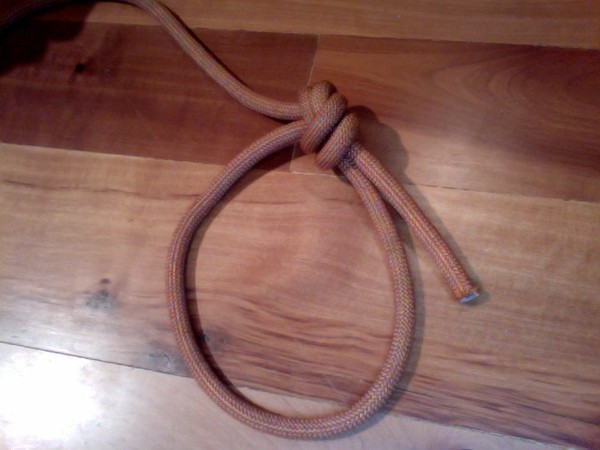Ring bend as tie-in knot?
|
|
Anybody familiar with this? It seems to work pretty well, much easier to untie than the figure 8 tie-in I've been using for decades. It's a little counter-intuitive, you tie a loop just as if you were making a a sling, except that your harness is within the loop and the standing end goes off to your partner. It's opposite the motion you use to tie the figure 8- in that case, you tie your figure 8, thread the rope through your harness, then feed the rope back through the knot, starting with the part of the knot closest to the harness and finishing with the running end of the rope going away from the harness. The ring bend tie-in starts the same way, just tie an overhand instead of a figure 8, but after threading through the harness, you start feeding it back through the knot on the end AWAY from the harness and aiming towards the harness. |
|
|
use a bowline with a yosemite finish. then tie a fishermans for a safety, google it for pics. super easy to untie after falling on it, and nearly as strong as a fig 8. just double check that it's tied correctly before you leave the ground. many people fuck the knot up or it comes untied while climbing cause people neglect to tie a safety. I'm careful and havne't had any problems yet. (knock on wood) |
|
|
Double bowline with a yosemite finish and a double fisherman back up is slightly stronger then a figure 8 last time I checked, that's what I've been using for years. The ring bend tie in method is called a "Brotherhood Knot" according to my AMGA SPI instructor Amos. He says he's taken some decent falls on it and it's up to snuff with AMGA standards. |
|
|
this guy: |
|
|
The "Brotherhood knot" is indeed in the AMGA/ACMG guides manual. here's a picture of it. Great knot. Easy to tie, easy to untie, easy to inspect, no tail sticking forward... |
|
|
It was a short-lived fad about two decades ago, then fell into obscurity. Appears to have re-emerged again but it doesn't have any real advantages. A bowline is faster to tie and easier to untie after a fall. A figure-8 is better for gym gumbies. |
|
|
Clyde wrote:It was a short-lived fad about two decades ago, then fell into obscurity. Appears to have re-emerged again but it doesn't have any real advantages. A bowline is faster to tie and easier to untie after a fall. A figure-8 is better for gym gumbies.I don't know, I find bowlines have an irritating habit of untying themselves. I like the "Brotherhood knot" and if the AMGA considers it safe, that's good enough for me. |
|
|
The AMGA has advocated a number of dumb things over the years, don't take their word for gospel. They used to recommend the inline figure-8 instead of the EDK too--bad idea. A properly tied bowline, which means backed up, is as secure all the other standards tie-in knots. Knot strength is irrelevant. |
|
|
Thanks to those who answered my question. Confirms my impression that the brotherhood knot is safe enough for my purposes. Clyde wrote:The AMGA has advocated a number of dumb things over the years,Haven't we all? Jason- are you still caving? Haven't seen any trip reports in a while. Mark |
|
|
Jason Kaplan wrote:Double bowline with a yosemite finish and a double fisherman back upOk this is a pet peeve of mine- the knot you are referring to is not a double fisherman's, or a single fishmerman's for that matter. It is a double overhand tied around the standing end, and the actual name of this knot is the 'strangle' knot. For simplicity and to avoid confusing people too much, I usually refer to it as the 'double overhand' knot (somewhat inaccurate, but close enough, and much better than calling it a fisherman's!). animatedknots.com/strangleend/ animatedknots.com/doubleove… |
|
|
Also be very wary of the bowline with yosemite finish! Even when the knot is tied correctly, if it is not dressed well, it can become a kind of slip knot when loaded. See the video below- it's confusing and you'll probably have to watch it a few times with a cord in your hands, but I was able to replicate this, and it's scary! |
|
|
Interesting as I have never heard of this Yosemite finish. The whole way they are tying the bow-line in the video is a cluster by tying the end to inside of the loop. The finish knot is threaded via the inside of the loop making it a complete cluster fuck. |
|
|
youtube.com/watch?v=h1YRhMP…
i use this double bowline as said above i havnt been able to replicate the failure of the yos finish. |
|
|
It is true that the Yosemite finish, if applied to a very loosely-tied bowline, can slip under a turn of the bowline knot and thereby create a different knot. It is impossible for this to happen if the bowline is even moderately snugged up first before the Yosemite finish is applied. I've never heard of anyone testing this slightly different knot, so have no idea how much worse it might be (if at all). To put this in perspective, the bowline itself can be loosely tied and then collapsed into an overhand knot with an end just sticking through it---so not a knot at all. |

 Continue with onX Maps
Continue with onX Maps Continue with Facebook
Continue with Facebook




















